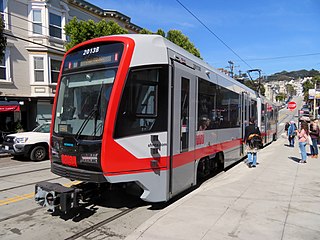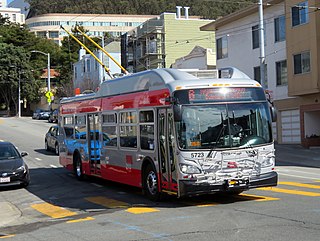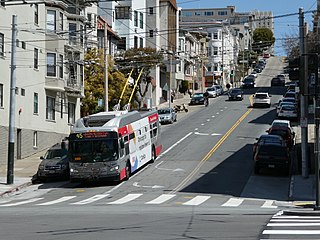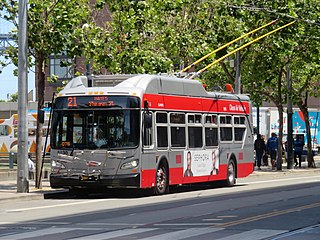
The San Francisco Municipal Railway ( MEW-nee; SF Muni or Muni), is the primary public transit system within San Francisco, California. It operates a system of bus routes, the Muni Metro light rail system, three historic cable car lines, and two historic streetcar lines. Previously an independent agency, the San Francisco Municipal Railway merged with two other agencies in 1999 to become the San Francisco Municipal Transportation Agency (SFMTA). In 2018, Muni served 46.7 square miles (121 km2) with an operating budget of about $1.2 billion. Muni is the seventh-highest-ridership transit system in the United States, with 114,721,200 rides in 2022, and the second-highest in California after the Los Angeles County Metropolitan Transportation Authority.

The F Market & Wharves line is one of several light rail lines in San Francisco, California. Unlike most other lines in the system, the F line runs as a heritage streetcar service, almost exclusively using historic equipment both from San Francisco's retired fleet as well as from cities around the world. While the F line is operated by the San Francisco Municipal Railway (Muni), its operation is supported by Market Street Railway, a nonprofit organization of streetcar enthusiasts which raises funds and helps to restore vintage streetcars.

The Boston-area trolleybus system formed part of the public transportation network serving Greater Boston in the U.S. state of Massachusetts. It opened on April 11, 1936, with a large network operating for the next quarter-century. Measured by fleet size, the Boston-area system was the second-largest trolleybus system in the United States at its peak, with only the Chicago system having more trolleybuses than Boston's 463. After 1963, the only remaining portion was a four-route cluster operating from the Harvard bus tunnel at Harvard station, running through Cambridge, Belmont, and Watertown. The Massachusetts Bay Transportation Authority took over the routes in 1964.

Van Ness Bus Rapid Transit is a bus rapid transit (BRT) corridor on Van Ness Avenue in San Francisco, California, United States. The 1.96-mile (3.15 km) line, which runs between Mission Street and Lombard Street, has dedicated center bus lanes and nine stations. It was built as part of the $346 million Van Ness Improvement Project, which also included utility replacement and pedestrian safety features. Van Ness Bus Rapid Transit is used by several San Francisco Municipal Railway (Muni) lines including the 49 Van Ness–Mission, as well as three Golden Gate Transit routes.

With five different modes of transport, the San Francisco Municipal Railway runs one of the most diverse fleets of vehicles in the United States. Roughly 550 diesel-electric hybrid buses, 300 electric trolleybuses, 250 modern light rail vehicles, 50 historic streetcars and 40 cable cars see active duty.

Duboce and Church is a light rail stop on the Muni Metro J Church and N Judah lines, located in the Duboce Triangle neighborhood of San Francisco, California. Just east of the station, the two lines enter the Market Street subway. The stop originally opened with the 22 Fillmore line in 1895. The station has complex layout with two side platforms in the middle of Duboce Avenue for the N Judah, one side platform in the middle of Church Street for northbound J Church trains entering the Market Street subway, and two mini-high platforms at the subway portal which provides access to both lines for people with disabilities.

The San Francisco trolleybus system forms part of the public transportation network serving San Francisco, in the state of California, United States. Opened on October 6, 1935, it presently comprises 15 lines and is operated by the San Francisco Municipal Railway, commonly known as Muni, with around 300 trolleybuses. In San Francisco, these vehicles are also known as "trolley coaches", a term that was the most common name for trolleybuses in the United States in the middle decades of the 20th century. In 2022, the system had a ridership of 33,664,000, or about 135,000 per weekday as of the third quarter of 2023.

33 Ashbury/18th Street is a trolleybus line operated by the San Francisco Municipal Railway. The route is descendant from the first trolleybus service to open in San Francisco.

14 Mission is a trolleybus line operated by the San Francisco Municipal Railway. It serves Mission Street between the Ferry Plaza and Daly City.

1 California is a trolleybus line operated by the San Francisco Municipal Railway (Muni). It provides service between the Richmond District and Financial District along California Street.
41 Union is a trolleybus line operated by the San Francisco Municipal Railway (Muni). It connects South of Market, the Financial District, Chinatown, North Beach, Russian Hill, and Cow Hollow.

24 Divisadero is a trolleybus line operated by the San Francisco Municipal Railway (Muni). Most of its north–south route takes it along Divisadero Street and Castro Street.

22 Fillmore is a trolleybus line operated by the San Francisco Municipal Railway (Muni). It connects the Marina District to the Dogpatch in San Francisco.

6 Haight/Parnassus is a trolleybus line operated by the San Francisco Municipal Railway (Muni). It connects the Financial District to the Inner Sunset and Forest Hill via Haight-Ashbury.

31 Balboa is a trolleybus line operated by the San Francisco Municipal Railway. It is one of several routes operating between the Financial District and the Richmond District.

3 Jackson is a suspended trolleybus line operated by the San Francisco Municipal Railway.

45 Union/Stockton is a trolleybus line operated by the San Francisco Municipal Railway. It connects Cow Hollow to South of Market via Russian Hill, Chinatown, and the Financial District.

21 Hayes is a trolleybus line operated by the San Francisco Municipal Railway (Muni). It connects the Civic Center to the neighborhoods northeast of Golden Gate Park in San Francisco.


















